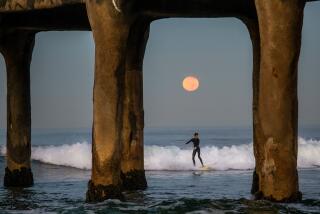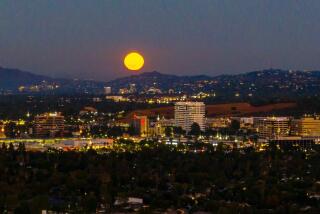Science / Medicine : CELESTIAL COVER-UP : Eclipse: Millions will see moon’s orb blot out sun Thursday. Event to provide wealth of scientific data.
The moon will throw its spell over the sun Thursday, and for a few brief moments the light that grants life will grow dark.
High atop a volcano on the Big Island of Hawaii, scores of astronomers will turn their telescopes toward the sun as the shadow of the moon, most fortuitously, passes directly over the world’s leading observatory.
On the beaches below, many who have traveled from distant lands will feel the air grow cooler and the sky grow dim.
Far away, on the tip of Baja California, thousands will wait for their moment without a sun.
To the south, millions more from Mexico to Brazil will hope for a parting of seasonal clouds so that they might share in the moment.
It will be like that, come Thursday, as more people watch a solar eclipse than at any time in history.
For astronomers, it will be a special moment because a solar eclipse gives them their best opportunity to study the atmosphere of the sun without being blinded by it. Only when the sun’s luminosity is blacked out can they turn some of their most sensitive instruments on the regions around the star. Why, they wonder, should the sun’s upper atmosphere, called its corona, be 300 times hotter than the surface of the sun?
Only an eclipse offers scientists such a rich opportunity to answer such questions, and this eclipse will be something special. Not only does it pass directly over two observatories on the island of Hawaii, its passage over the equatorial region will make it linger far longer than most eclipses. Many who would do almost anything for just a few seconds of “totality” will have from four to 6 1/2 minutes to enjoy this one.
Instruments around the world, not just those in the path of the eclipse, will study the sun simultaneously to give scientists an unprecedented treasure chest when it is all over.
At the exact moment that the total eclipse reaches Hawaii, Leon Golub and several colleagues from the Harvard-Smithsonian Center for Astrophysics will launch a rocket from White Sands, N.M. The rocket will carry an X-ray telescope on a five-minute flight--almost the exact length of the total eclipse--to make X-ray images of turbulent areas in the sun’s corona.
Meanwhile, half a world away, scientists in the Canary Islands will study the sun with different instruments.
While both experiments are under way, scientists from the University of Hawaii expect to capture spectacular images of the corona as the moon blocks out the sun.
Later, the three teams will pool their research. Data from White Sands and the Canary Islands will tell them precisely what was happening on the sun at the time of the eclipse--in the form of such things as sunspots and turbulent storms. The Hawaii results should allow them to study the relationship between solar events and the corona.
Myths and Legends
* In Tahiti, it was believed that eclipses occur during lovemaking between the sun and moon in order to obscure one another. The offspring of this union was thought to be the stars.
* According to Herodotus, a total eclipse of the sun occurred during a battle between the Medes and the Lydians in 585 B.C. It so moved the combatants that they ended their warring.
* Some North American Indian tribes interpreted eclipses as the death or sickness of the heavenly bodies. Others believed that celestial coyotes hunted stars during the event.
* It goes with the job: During the Hsia Dynasty (from about 2200-1500 B.C.), two Chinese astronomers, Hsi and Ho-who failed to predict an eclipse-were decapitated.
Watching the Solar Show
Looking at the sun, even for a few moments, can be dangerous to the eyes. During the partial phase of an eclipse, viewers should never look directly at the sun even though it may appear to be dim. However, there are several ways to watch an eclipse safely:
* The best way is to build a solar projector that works the same as a pinhole camera. You can make a simple one with two pieces of white cardboard. Punch a tiny hole in one and hold it so that sunlight passes through the hole and onto the second piece of cardboard. The image of the eclipse will be projected onto the second piece, and it can be enlarged simply by separating the two pieces farther.
* Welders goggles with a rating of 14 or higher are the best filters.
* Experts recommend against making filters with smoked glass or exposed photographic film; any inconsistencies may let unfiltered sunlight through.
* Only during the period of totality can the eclipse be viewed without filters. (There will be only a partial eclipse in Los Angeles.)
A Scientific Bonanza
Seven of the nine telescopes on top of Mauna Kea, the leading observatory in the world, will turn toward the sun while several telescopes on the Mauna Loa Observatory, which normally monitor the sun, will work overtime. Among the items to be studied:
* Details in the sun’s atmosphere and infrared and microwave radiation from the sun.
* A Caltech team hopes to measure the temperature of the layers of the solar atmosphere more precisely than it has ever been done by determining changes as the moon slowly slices off sections of the corona, the sun’s atmosphere.
* Solar telescopes will take advantage of the blockage of the sun’s bright light to analyze the composition and magnetic fields of various layers above the sun’s surface.
During a total eclipse of the sun, the tip of the moon’s shadow touches the earth and the moon’s velocity carries the shadow rapidly forward. Only along a narrow path (the umbra) is the eclipse total. In the penumbra (lighter diverging cone), a fraction of the sunlight is blocked, resulting in a partial eclipse.
Facts on Following the Moon’s Shadow
The Kona Coast of Hawaii’s Big Island and the tip of Baja California are generally regarded as the best places to view the eclipse. It will also be visible from Mexico, Central America and Brazil, but weather conditions are not likely to be as favorable. Southern California will see only a partial eclipse because the moon, at this latitude, will not cover the entire sun. In Los Angeles, the partial eclipse will begin at 10:12 a.m. and end at 12:47 p.m., but a maximum of only 74% of the sun will be obscured.
Eclipses by the Year
* Usually, there are between two and four solar eclipses per year.
* Years in which there were or will be only two solar eclipses: 1989, 1990, 1991.
* In 1805, 1935, 2206, 2709 there were or will be five solar eclipses.
Varying Views
A. La Paz, Mexico
B. Punta Abreojos, Mexico
C. Los Angeles
D. Monterey, Calif.
E. Portland, Ore.
F. Prince Rupert, Canada
Eclipse will be accessible to tens of millions of people-more than any other eclipse in history-and it will also be one of the longest.
North America will not have a significant total eclipse until the year 2017, and that will last only two and a half minutes.
In some regions, the total eclipse will last up to six minutes and 54 seconds.
Eclipse will pass directly over the world’s leading astronomical observatory atop Mauna Kea in Hawaii. Scientists will have a prime opportunity to study the sun’s atmosphere, or corona, which is normally overwhelmed by the brilliance of the sun.
The eclipse will end over the Atlantic Ocean after passing over Brazil.
Total Eclipse Sites
Partial Mid- Partial Duration begins Eclipse Ends of totality Hilo, Hawaii 6:30 a.m. 7:30 a.m. 8:38 a.m. 4 min. 07 sec. La Paz, Mexico 10:23 a.m. 11:50 a.m. 1:18 p.m. 6 min. 26 sec. Mazatlan, Mexico 10:32 a.m. 12:01 p.m. 1:28 p.m. 5 min. 41 sec. Guadalajara, Mexico 11:42 a.m. 1:12 p.m. 2:38 p.m. 6 min. 18 sec. Mexico City 11:54 a.m. 1:24 p.m. 2:47 p.m. 6 min. 42 sec.






